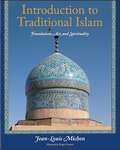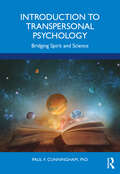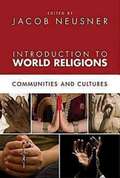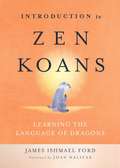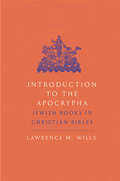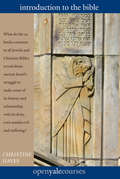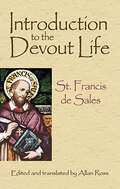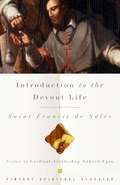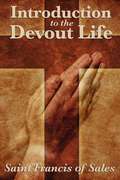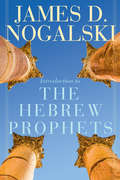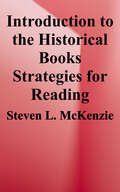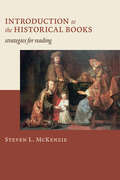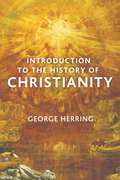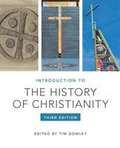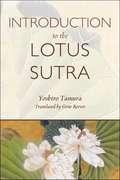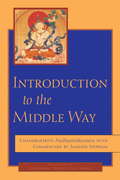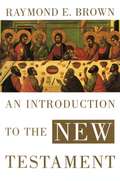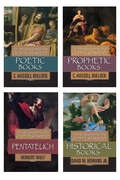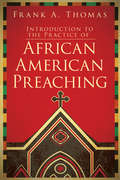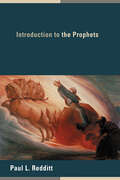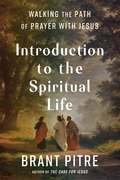- Table View
- List View
Introduction to Traditional Islam: Foundations, Art and Spirituality
by Jean-Louis MichonBehind the clamorous headlines of militant and political Islam lies a more serene and cultivated form of traditional Islam. Jean-Louis Michon, a UNESCO advisor tasked with preserving the architectural and artistic heritage of Islam, unveils this lesser-known dimension of the world's second largest religion.
Introduction to Transpersonal Psychology: Bridging Spirit and Science
by Paul F. Cunningham, Ph.D.Introduction to Transpersonal Psychology: Bridging Spirit and Science provides an accessible and engaging introduction to this complex and evolving field. Adopting a modular approach, the book systematically relates key themes of Transpersonal Psychology to three major areas within psychology: general psychology, experimental psychology, and clinical psychology. Covering a wide range of topics including transpersonal states of consciousness, biological foundations, research methods, and cognition, the book also features extensive discussion of transpersonal theorists and the impact of their work on our understanding of psychological concepts. The book also introduces contemporary developments in the field and anticipates future advances such as feminist perspectives and cross-cultural approaches alongside practical experiments designed to give transpersonal theories and concepts psychological roots. A critical evaluation of both mainstream and transpersonal theories and research is applied throughout to foster analytical skills and encourage critical and scientific thinking about humanity’s nature as spiritual creatures and ways to educate for personal and social transformation. Accompanied by an online instructor’s manual, this book will be an essential companion for all students of Transpersonal or Humanistic Psychology, or those interested in applying transpersonal ideas to mainstream psychological research.
Introduction to World Christian History
by Derek CooperChristianity is a global faith. Today, people are increasingly aware that Christianity extends far beyond Europe and North America, permeating the Eastern and Southern hemispheres. What we may know less well is that Christianity has always been a global faith. A vast untold story waits to be heard beyond the familiar tale of how the Christian faith spread across Europe. Not only was Jesus born in Asia, but in the early years of the church Christianity found fertile soil in Africa and soon extended to East Asia as well. In this brief introduction to world Christian history, Derek Cooper explores the development of Christianity across time and the continents. Guiding readers to places like Iraq, Ethiopia and India, Scandanavia, Brazil and Oceania, he reveals the fascinating—and often surprising—history of the church.
Introduction to World Religions: Communities and Cultures
by Jacob NeusnerWith an emphaisis on communities of faith, this accessible book will introduce students to the classic texts, important events, key figures, defining rituals, essential creeds and symbols of world religions. Contents: Introduction by William Scott Green Judaism A. Judaism: Beginnings: Religion of Ancient Israel by Baruch A. Levine B. Judaism: The Formation by Jacob Neusner C. Judaism in Modern Times: Reform, Orthodox, and Conservative Judaism, Zionism by Jacob Neusner 2. Christianity A. Christianity: Beginnings by Bruce Chilton B. Christianity: Roman Catholicism by Lawrence S. Cunningham C. Orthodox Christianity by J. A. McGuckin D. Christianity: Protestantism by Martin E. Marty 3. Islam A. Islam: Beginnings by Th. Emil Homerin B. Islam: The Shiite Tradition by Liyakat Takim C. Islam: The Sunni Tradition by Th. Emil Homerin 4. Hinduism by Douglas Brooks 5. Buddhism A. Buddhism: Beginnings by Mario Poceski B. Buddhism: The Theravada Tradition by Kristen Scheible C. Buddhism: The Mahayana Tradition by Mark L. Blum 6. Daoism by Mark Meulenbled 7. Confucianism by Mark A. Csikszentmihalyi 8. Shinto by James L. Ford 9. Indigenous Religions A. Indigenous Religious Tradition by Jualynne E. Dodson and Soyna Maria Johnson B. African Indigenous Religions by Jacob Olupona 10. New 19th Century American Religions by Danny L. Jorgensen 11. New 20th Century American Religions by Dell deChant
Introduction to Zen Koans: Learning the Language of Dragons
by James Ishmael FordAn indispensible guide to koans, teaching the reader about the importance of lineage, the practice of “just sitting,” and koan practice as paths to awakening.“This marvelous book opens the treasure house of Zen and yet, happily, does not dispel its mystery. James Ford, an excellent storyteller and longtime Zen practitioner, presents a detailed and beautiful description of the craft of zazen, including “just sitting” and various forms of breath meditation—but focuses primarily on koan introspection. The power of koans, these 'public cases' from China, has never ceased to enrich my own experience of Zen. They are a medium of exploration of the history, culture, and view of Zen, but most importantly are a medium of awakening. James Ford is fundamentally a koan person, and for this, the book is particularly rich, opening the practice of koans in a splendid way. I am grateful for his long experience as a teacher and practitioner of this rare and powerful practice. Since the word koan has found its way into popular English usage, I am grateful too for the more nuanced and fertile view of koans that Ford presents. His definition of the word is telling: “a koan points to something of deep importance, and invites us to stand in that place.” He has also has created a wonderful translation of the Heart Sutra, Zen’s central scripture—and carefully opens up the heart of the Heart Sutra through scholarship and practice. Rich in textual sources and woven throughout with the perspectives of contemporary teachers, Introduction to Zen Koans sheds new light on ancient teachings. Through it, the reader will discover the importance of lineage, the traceless traces of the Zen ancestors, and the places of “just sitting” and koan practice as paths to awakening, as the great doorways into Zen.” —from the foreword by Joan Halifax
Introduction to the Apocrypha: Jewish Books in Christian Bibles
by Lawrence M. WillsAn ambitious introduction to the Apocrypha that encourages readers to reimagine what &“canon&” really means Challenging the way Christian and non-Christian readers think about the Apocrypha, this is an ambitious introduction to the deuterocanonical texts of the Christian Old Testaments. Lawrence Wills introduces these texts in their original Jewish environment while addressing the very different roles they had in various Christian canons. Though often relegated to a lesser role, a sort of &“Bible-Lite,&” these texts deserve renewed attention, and this book shows how they hold more interest for both ancient and contemporary communities than previously thought.
Introduction to the Bible
by Christine HayesThis book examines the small library of 24 books common to all Jewish and Christian Bibles—books that preserve the efforts of diverse writers over a span of many centuries to make sense of their personal experiences and those of their people, the ancient Israelites. Professor Christine Hayes guides her readers through the complexities of this polyphonous literature that has served as a foundational pillar of Western civilization, underscoring the variety and even disparities among the voices that speak in the biblical texts. Biblical authors wrote in many contexts and responded to a sweeping range of crises and questions concerning issues that were political, economic, historical, cultural, philosophical, religious, and moral. In probing chapters devoted to each of the 24 books of the Hebrew Bible, or Old Testament, Hayes reconstructs the meanings and messages of each book and encourages a deeper appreciation of the historical and cultural settings of ancient biblical literature.
Introduction to the Bible: The Nature, History, Authorship and Content of the Holy Bible with Selections from and Commentaries on the Various Books
by John Laux Carl J. RyanCatholics who feel lost when facing Bible study will find this an extremely valuable, very thorough orientation to Sacred Scripture. Gives an introduction to each of the Bible's 72 books, with well-chosen Scriptural passages, using the Douay-Rheims Bible.
Introduction to the Devout Life
by St. Francis de Sales Allan RossThis masterpiece of Christian literature by a 16th-century priest explains how to live a holy life in the secular world. Drawn from the letters of St. Francis de Sales, it presents clear and direct advice about praying, resisting temptation, and maintaining devotion to God. A key figure in France's Counter Reformation, St. Francis de Sales (1567-1622) served as Bishop of Geneva and was canonized in 1665. The popularity of his prolific writings on spirituality led to his nomination as the patron saint of authors and journalists. Today's readers feel a special affinity for St. Francis, whose suggestions for living a truly Christian life don't involve withdrawal from the world. In this enduring spiritual guide, his remarkably modern advice appears in the form of letters. The saint's frank and practical counsel ranges from embracing meditations that strengthen the resolve to maintain a virtuous existence to performing daily exercises that renew the soul.
Introduction to the Devout Life
by Francis De Sales Edward M. EganFrancis de Sales's Introduction to the Devout Life has remained a uniquely accessible and relevant treasure of devotion for nearly four hundred years. As Bishop of Geneva in the first quarter of the seventeenth century, Francis de Sales saw to the spiritual needs of everyone from the poorest peasants to court ladies. The desire to be closer to God that he found in people from all levels of society led him to compile these instructions on how to live in Christ. Francis's compassionate Introduction leads the reader through practical ways of attaining a devout life without renouncing the world and offers prayers and meditations to strengthen devotion in the face of temptation and hardship.
Introduction to the Devout Life
by St. Francis de SalesFrancis de Sales's Introduction to the Devout Life has remained a uniquely accessible and relevant treasure of devotion for nearly four hundred years. As Bishop of Geneva in the first quarter of the sevenjteenth century, Francis de Sales saw to the spiritual needs of everyone from the poorest peasants to court ladies. The desire to be closer to God that he found in people from all levels of society led him to compile these instructions on how to live in Christ. Francis's compassionate Introduction leads the reader through practical ways of attaining a devout life without renouncing the world and offers prayers and meditations to strengthen devotion in the face of temptation and hardship.
Introduction to the Hebrew Prophets
by James D. NogalskiFollowing the Hebrew canon, the author offers a basic introduction, which includes critical issues such as authorship, unity, dates of composition and revision, and structure. Drawing upon current scholarship, Dr. Nogalski shows how these issues are relevant to the theological themes and movements that help characterize the text and hold meaning for us.The last decades have seen many changes when it comes to the study of the four Latter Prophets (Isaiah, Jeremiah, Ezekiel, and the book of the Twelve). Among others, these changes have identified a greater role for the prophetic scroll – not merely the prophetic character – as a vehicle for conveying the prophetic message. Nogalski’s introduction to the prophets invites modern readers to hear these scrolls through the processes that shaped them, to recognize the thematic threads that traverse them, and to react to the words that confront religious and ethical complacency, that speak truth to power, and that offer hope to the oppressed.Each chapter will include a brief bibliography for further reading and discussion questions to help students focus on key concepts.
Introduction to the Historical Books: Strategies for Reading
by Steven L. McKenzieThe author here surveys the historical books of the Old Testament—Joshua through Ezra-Nehemiah—for their historical context, contents, form, and themes, communicating them clearly and succinctly for an introductory audience. <p><p>By providing a better understanding of biblical history writing in its ancient context, the author helps readers come to terms with tensions between the Bible’s account and modern historical analyses. Rather than denying the results of historical research or dismissing its practitioners as wrongly motivated, he suggests that the source of the perceived discrepancy may lie not with the Bible but with the way in which it has been read. He also calls into question whether the genre of the Bible’s historical books has been properly understood.
Introduction to the Historical Books: Strategies for Reading
by Steven L. McKenzieSteven McKenzie here surveys the historical books of the Old Testament — Joshua through Ezra-Nehemiah — for their historical context, contents, form, and themes, communicating them clearly and succinctly for an introductory audience. / By providing a better understanding of biblical history writing in its ancient context, McKenzie helps readers come to terms with tensions between the Bible’s account and modern historical analyses. Rather than denying the results of historical research or dismissing its practitioners as wrongly motivated, he suggests that the source of the perceived discrepancy may lie not with the Bible but with the way in which it has been read. He also calls into question whether the genre of the Bible’s historical books has been properly understood.
Introduction to the History of Christianity
by George HerringChristianity is the world’s largest religion, and has had a profound impact on the course of civilization. Introduction to the History of Christianity is a beautifully crafted and clearly written introduction to Christianity over its 2000 year history. The broad underlying theme of the book is the interaction between Christianity and the secular world, exploring how one has shaped and been shaped by the other. The volume does not attempt to cover the whole of Christian history in detail. It focuses on three key chronological periods pivotal in the development of Christianity: Christ and Caesar, Christianity circa 300–500; Expansion and Order, Latin Christendom, circa 1050–1250; and Grace and Authority, Western Christianity, circa 1450–1650, as well as a concluding section on Christianity in the modern world, providing illustrative snapshots of the tradition over the course of its long development. In addition, the volume includes maps, timelines, quotations from primary source material, a glossary, and a further reading section. No staid, laborious introduction to its subject, Introduction to the History of Christianity offers an inviting and informative overview of this rich religious tradition.
Introduction to the History of Christianity
by Tim DowleyNow in its third edition, Tim Dowley's masterful one-volume survey of church history has an updated design and new content, particularly in the section covering most recent Christian history. The inviting full-color format includes many new images and updated maps, while maintaining many of the features that made the second edition a popular volume for the classroom. Dowley has assembled a global cast of respected scholars to write the full story of the rise of the Christian faith and to provide a rounded picture of the worldwide development of Christianity. The volume has been praised as accurate, scholarly, and balanced. Its writers are committed to Christianity but also to the unhindered pursuit of truth that does not avoid the darker aspects of the varied story of Christianity. <P><P>The accessible text is supported by detailed timelines, maps, profiles of key figures in Christianity, colorful images, and a complete glossary. Each section includes questions for discussion.
Introduction to the Lotus Sutra
by Gene Reeves Michio Shinozaki Yoshiro TamuraThe Lotus Sutra--one of the most popular Buddhist classics--is here accessibly introduced by one of its most eminent scholars."Soon after entering university in December of 1943, I was sent to the front as a student soldier. I wondered if I were allowed to bring but a single book on the trip, possibly to my death, which would I want to bring. It was the Lotus Sutra" -- from the author's Preface. Having developed a lifelong appreciation of the Lotus Sutra -- even carrying a dog-eared copy with him through service in World War II -- Yoshiro Tamura sought to author an introduction to this beloved work of Buddhist literature. Tamura wanted it to be different than other basic explorations of the text; his introduction would be plain-spoken, relevant and sensitive to modern concerns, and well-informed by contemporary scholarship. He succeeded marvelously with Introduction to the Lotus Sutra, which Gene Reeves -- Tamura's student and translator of the popular English edition of The Lotus Sutra -- translates and introduces in English for the first time here. Tackling issues of authenticity in the so-called "words of Buddha," the influence of culture and history on the development of the Lotus Sutra, and the sutra's role in Japanese life, Introduction to the Lotus Sutra grounds this ancient work of literature in the real, workaday world, revealing its continued appeal across the ages.
Introduction to the Middle Way: Chandrakirti's Madhyamakavatara with Commentary by Ju Mipham
by ChandrakirtiIntroduction to the Middle Way presents an adventure into the heart of Buddhist wisdom through the Madhyamika, or "middle way," teachings, which are designed to take the ordinary intellect to the limit of its powers and then show that there is more. This book includes a verse translation of the Madhyamakavatara by the renowned seventh-century Indian master Chandrakirti, an extremely influential text of Mahayana Buddhism, followed by an exhaustive logical explanation of its meaning by the modern Tibetan master Jamgön Mipham, composed approximately twelve centuries later. Chandrakirti's work is an introduction to the Madhyamika teachings of Nagarjuna, which are themselves a systematization of the Prajnaparamita, or "Perfection of Wisdom" literature, the sutras on the crucial but elusive concept of emptiness. Chandrakirti's work has been accepted throughout Tibetan Buddhism as the highest expression of the Buddhist view on the sutra level. With Jamgön Mipham's commentary, it is a definitive presentation of the wisdom of emptiness, a central theme of Buddhist teachings. This book is a core study text for both academic students and practitioners of Mahayana and Vajrayana Buddhism.
Introduction to the New Testament
by Raymond E. BrownEvery generation needs a comprehensive, reliable Introduction to the New Testament that opens the biblical text to the novice. Raymond E. Brown's An Introduction to the New Testament is the most trustworthy and authoritative guidebook for a generation seeking to understand the Christian Bible. Universally acknowledged as the dean of New Testament scholarship, Father Brown is a master of his discipline at the pinnacle of his career. Who else could cover the entire scope of the New Testament with such ease and clarity? This gifted communicator conveys the heartfelt concern of a beloved teacher for his students, as he walks the reader through the basic content and issues of the New Testament. While the book contains a wealth of information, its most impressive features are how the author boils down a life time of scholarship into basic summaries of each book, provides a historical overview of the ancient Greco-Roman world, engages in discussions of theological issues, and presents supplementary material for deeper understanding, such as tables, maps, bibliographies, and appendixes. Those opening to the New Testament for the first time and those seeking deeper insights could not ask for more in a primer to the Christian Bible.
Introduction to the Old Testament
by Bill T. ArnoldThis volume introduces ancient Israel's Scriptures, or the Hebrew Bible, commonly called the Old Testament. It also traces the legacy of monotheism first found in the pages of the Old Testament. Where pertinent to the message of the Old Testament, the book explores issues of history, comparative religions, and sociology, while striking a balance among these topics by focusing primarily on literary features of the text. In addition, frequent sidebar discussions introduce the reader to contemporary scholarship, especially the results of historical-critical research and archaeology. Along the way, the book explores how the Old Testament conceptualized and gave rise to monotheism, one of the most significant developments in history. - Pays unique attention to the origins of monotheism, the common heritage of Jews, Christians, and Muslims - Includes generous number of illustrations, 20 freshly created maps, and frequent sidebar discussions in each chapter, as well as concise chapter summaries and glossary of terms - Has a web component that includes study guides, flashcards, PowerPoint lecture slides and a test bank
Introduction to the Old Testament, set of four books (Prophetic, Poetic, Pentateuch, Historical)
by C. Hassell Bullock Herbert Wolf David M. Howard Jr.This package contains all four books of An Introduction to the Old Testament set: An Introduction to the Old Testament Historical Books, An Introduction to the Old Testament Poetic Books, An Introduction to the Old Testament Prophetic Books,and An Introduction to the Old Testament Pentateuch.In An Introduction to the Old Testament Historical Books, incredible events, amazing love stories, larger-than-life personalities and deep theological implications and themes are just part of the treasure that awaits readers. These books tell the story of the nation of Israel and the God who loves her, punishes her, and always brings this recalcitrant people back to Himself. In An Introduction to the Old Testament Poetic Books, C. Hassell Bullock, a noted Old Testament scholar, delves deep into the hearts of the five poetic books, offering readers helpful details such as hermeneutical considerations for each book, theological content and themes, detailed analysis of each book, and cultural perspectives. In An Introduction to the Old Testament Prophetic Books, C. Hassell Bullock presents a clear picture of some of history's most profound spokesmen--the Old Testament prophets--and the God who shaped them. Our generational distance from the age of the prophets might seem to be a measureless chasm. Yet we dare not make the mistake of assuming that passing years have rendered irrelevant not only the Old Testament prophets, but also the God who comprehends, spans, and transcends all time. In An Introduction to the Old Testament Pentateuch, Old Testament expert Herbert Wolf provides layreaders and scholars alike with a strong undergirding of understanding and knowledge in this introduction that reveals both the seriousness and excitement of the Pentateuch.
Introduction to the Old Testament, set of four books (Prophetic, Poetic, Pentateuch, Historical)
by C. Hassell Bullock Herbert Wolf David M. Howard Jr.This package contains all four books of An Introduction to the Old Testament set: An Introduction to the Old Testament Historical Books, An Introduction to the Old Testament Poetic Books, An Introduction to the Old Testament Prophetic Books,and An Introduction to the Old Testament Pentateuch.In An Introduction to the Old Testament Historical Books, incredible events, amazing love stories, larger-than-life personalities and deep theological implications and themes are just part of the treasure that awaits readers. These books tell the story of the nation of Israel and the God who loves her, punishes her, and always brings this recalcitrant people back to Himself. In An Introduction to the Old Testament Poetic Books, C. Hassell Bullock, a noted Old Testament scholar, delves deep into the hearts of the five poetic books, offering readers helpful details such as hermeneutical considerations for each book, theological content and themes, detailed analysis of each book, and cultural perspectives. In An Introduction to the Old Testament Prophetic Books, C. Hassell Bullock presents a clear picture of some of history's most profound spokesmen--the Old Testament prophets--and the God who shaped them. Our generational distance from the age of the prophets might seem to be a measureless chasm. Yet we dare not make the mistake of assuming that passing years have rendered irrelevant not only the Old Testament prophets, but also the God who comprehends, spans, and transcends all time. In An Introduction to the Old Testament Pentateuch, Old Testament expert Herbert Wolf provides layreaders and scholars alike with a strong undergirding of understanding and knowledge in this introduction that reveals both the seriousness and excitement of the Pentateuch.
Introduction to the Practice of African American Preaching
by Frank A. ThomasThe Introduction to African American Preaching is an important,groundbreaking book. This book acknowledges African American preachingas an academic discipline, and invites all students and preachers into ascholarly, dynamic, and useful exploration of the topic.AuthorFrank Thomas opens with a "bus tour" study of African Americanpreaching. He shows how African American preaching has gradually movedfrom an almost exclusively oral to an oral/written tradition. Readerswill gain insight into the history of the study of the African Americanpreaching tradition, and catch the author’s enthusiasm for it.NextThomas traces the relationship between homiletics and rhetoric inWestern preaching, demonstrating how African American preaching isinherently theological and rhetorical.He then explores thequestion, "what is black preaching?" Thomas introduces the reader tomethods of "close reading" and "ideological criticism." And thendemonstrates how to use these methods, using a sermon by Gardner CalvinTaylor as his example.The next chapter considers the question, "what is excellence in black preaching?"Thenext chapter seeks to create bridges and dialogue within the field ofhomiletics, and in particular, the Euro-American homiletic tradition.The goal of this chapter is to clearly demonstrate connections betweenthe African American preaching tradition and the field of homiletics.Thomasnext turns to questions about the relevancy of the church to theMillennial generation. Specifically, how will the African Americanchurch remain relevant to this generation, which is so deeply concernedwith social justice?
Introduction to the Prophets
by Paul L. ReddittWriting in a conversational rather than a scholarly tone, Paul Redditt assumes little or no prior knowledge of the Old Testament as he presents and introduces the Major and Minor Prophets in the canonical order of the English Bible. The chapters of Redditt's Introduction to the Prophets discuss the place of each book in the canon; the literary setting of each book; their structure, integrity, and authorship; the main genre(s) in each; special features of each book; basic emphases of each book; and problems -- theological, literary, or historical -- raised by a study of the book. Among other things, Redditt demonstrates that the prophets were both &“foretellers&” and &“forthtellers,&” and he argues that the Old Testament prophets developed the concept of monotheism. Each chapter ends with questions for further reflection. Concluding the volume are a helpful glossary and several indexes.
Introduction to the Spiritual Life: Walking the Path of Prayer with Jesus
by Brant PitreA compelling exploration of the biblical foundations, contemplative practices, and spiritual path of Jesus himself—from the bestselling author of The Case for Jesus&“What happens when a biblical theologian explores classic spirituality? This book. Pitre&’s students have asked, Why have we never heard this before? The reader wonders the same.&”—Dr. David Fagerberg, author of Liturgical Mysticism The path of following Jesus is an ancient and storied spiritual tradition. Yet many believers are not familiar with the three major forms of prayer and the three stages of spiritual growth that exist to bring them closer to God.In his most personal book yet, Dr. Brant Pitre draws on the riches of the Bible, the words of Jesus, and the writings of mystics across the centuries to shed light on the mystery—and wonder—of the spiritual life.Starting with the age-old belief that the path of prayer is not only informative but transformative, Dr. Pitre explores• the scriptural roots of vocal, meditative, and contemplative prayer• the purgative, illuminative, and unitive stages of spiritual growth• the spiritual exercises of prayer, fasting, and almsgiving• the Jewish roots of the Lord&’s Prayer• Lectio Divina: how to pray with the Bible• seven vices and their seven opposing virtues• the battle of prayer: how to deal with difficulty and distractions• the &“dark night of the soul&” in the ScripturesFull of sacred truths, contemplative insights, and practical steps, Introduction to the Spiritual Life is a veritable biblical road map of the spiritual landscape that enables us to follow Jesus as our primary guide.
